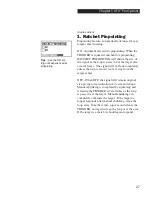
14
Chapter 4 DFX
™
Basic Adjustments
Basic Adjustments
Basics of Basic Adjustment
After you have had some fi eld experience, you may
want to make some changes to the basic settings
of your detector.
From the search mode press
MENU
. At this point, the MAIN MENU will ap-
pear on the display. Use the ARROW controls to
move the pointer to Basic Adjustments,
and then
press ENTER.
You may now
use the ARROW
down
control to scroll
through the Basic Adjust-
ments.
Using the fi rst adjustment screen (TARGET VOL-
UME) as an example, the screens with a
graphic
control knob
require you to fi rst
press ENTER
require you to fi rst
require you to fi rst
then use the ARROW up and down controls to
adjust.
Note: when ENTER is pressed the square
around the title moves to the setting, indicating you
are ready to make adjustments with the ARROW
controls.
After adjusting press MENU
and use
the ARROW controls to continue viewing/setting
other Basic Adjustments, or squeeze and release the
TRIGGER to begin searching
Adjustment screens with an on/off selection need
only for you to press ENTER to change setting.
Pressing ENTER again changes back to the original
setting.
(press ENTER)
(press ENTER)
RECTANGLE AROUND
THE TITLE MOVES TO
THE SETTING
USE ARROW KEYS TO
ADJUST THE SETTING
UP OR DOWN
ADJUSTMENT
EXAMPLE:
TIP
- To quickly increase to
maximum, hold ENTER and
press ARROW up. To quickly
decrease to minimum, hold
the ENTER and press AR-
ROW down.
ADJUSTMENT
EXAMPLE:
1. TARGET VOLUME -
How loud a target beeps when detected.
2. AUDIO THRESHOLD -
The slight hum or background sound heard continuously during searching.
3. TONE (AUDIO FREQUENCY) -
Selects the frequency or pitch of sound the detector produces.
4. AUDIO DISCRIMINATION -
The ability to reject trash, different sounds for different types of targets.
5. SILENT SEARCH -
The ability to operate without the threshold or background hum.
6. MIXED-MODE -
DC non-discriminate mode, working simultaneously with AC discrimination mode.
7. A.C. SENSITIVITY -
Degree instrument is responsive to signals in the discriminate (motion) modes.
8. D.C. SENSITIVITY -
Degree instrument is responsive to signals in non-discriminate (non-motion)
modes.
9. BACKLIGHT -
Used in dark conditions to light the display improving visibility.
10. VIEWING ANGLE -
Adjusts the display for low or high temperature visibility.
Basic Adjustments - what do they do?
Содержание DFX
Страница 1: ......






























